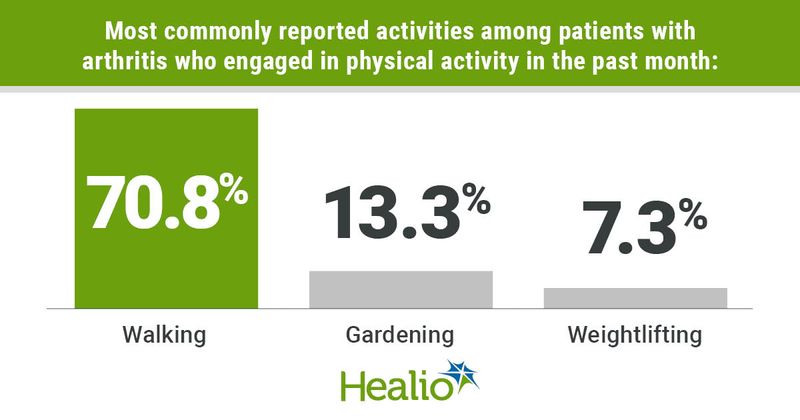Walking tops list of exercises among adults with arthritis engaged in physical activity
Among patients with arthritis who engaged in physical activity in the past month, about 71% reported walking as one of their two most frequent activities, followed by gardening and weightlifting, according to CDC researchers.
“The numerous health benefits of physical activity include reduced risk for chronic disease and improved mental health and quality of life,” Dana Guglielmo, MPH, who at the time of the study was with the CDC’s National Center for Chronic Disease Prevention and Health Promotion, and colleagues wrote in Morbidity and Mortality Weekly Report. “Physical activity can improve physical function and reduce pain and fall risk among adults with arthritis, a group of approximately 100 conditions affecting joints and surrounding tissues (most commonly osteoarthritis, fibromyalgia, gout, rheumatoid arthritis, and lupus).”

“Despite these benefits, the 54.6 million U.S. adults currently living with arthritis are generally less active than adults without arthritis, and only 36.2% of adults with arthritis are aerobically active (ie, meet aerobic physical activity guidelines),” they added. “Little is known about which physical activities adults with arthritis engage in.”
To analyze the most common nonwork-related physical activities among those adults with arthritis who reported engaging in any physical activity in the past month, Guglielmo and colleagues examined data from the 2019 Behavioral Risk Factor Surveillance System (BRFSS). According to the researchers, the BRFSS is an ongoing, state-based survey of noninstitutionalized U.S. adults. The survey is conducted over landline and cell phone by health departments in 50 states, Washington, D.C., and U.S. territories.
For this analysis, the researchers included 2019 data from 49 states and Washington, D.C., excluding New Jersey due to lack of data. Patients with arthritis were identified through a survey question that asked, “Have you ever been told by a doctor or other health care professional that you have arthritis, rheumatoid arthritis, gout, lupus or fibromyalgia?” Physical activity was defined based on an affirmative answer to the question, “During the past month, other than your regular job, did you participate in any physical activities or exercises such as running, calisthenics, golf, gardening, or walking for exercise?”
Among the 380,418 respondents who reported their arthritis status, age and physical activity status, 87,299 said they had arthritis and engaged in physical activity. These participants were then additionally asked to report up to two of their most common activities from a list of 74 total activities.
According to the researchers, 67.2% of adults with arthritis reported engaging in physical activity in the past month. Among these patients, the most commonly reported activities were walking, at 70.8%; gardening, at 13.3%; and weightlifting, at 7.3%. Across 45 U.S. states, at least two-thirds of adults with arthritis who engaged in physical activity reported walking.
“To promote physical activity among adults with arthritis, health care providers can offer advice or counseling for walking or referrals to low-cost, evidence-based physical activity programs,” Guglielmo and colleagues wrote. “These programs might help adults with arthritis overcome common barriers to physical activity, including cost, lack of instructions about preventing risk for injury while exercising, and fear of arthritis worsening.”
“Communities can address physical environment barriers to walking by providing safe and supportive infrastructures such as sidewalks, benches and green spaces,” they added. “Promoting engagement in physical activity among adults with arthritis can reduce their risk for chronic health conditions and improve their mental health and quality of life.”
